| 3DNews Vendor Reference English Resource - All you need to know about your products! |
|
||||||||
 |
|||||||||
|
IntroductionIn 2004/2005, the battle among the manufacturers of processors and cooling devices came up with a bang. Intel released new processors whose heat emission was too much even for "boxed" coolers. The other competitors started desperately developing coolers having huge radiators and/or heat pipes. Complication of the design ended up in the appropriate result: coolers turned more expensive. Some models have already exceeded the 50$ bar and are coming close to 60$. It's not possible to raise the price further: with 90$-100$ you can already buy a water-cooled system (some manufacturers are already promising to produce a water-cooled system at 30$ - for details, read the coverage of Cebit 2005). Somehow or other, we got the impression that even with the use of heat pipes the efficiency of air-cooled systems has approached its technology limit. It's no longer possible to further improve the products without raising the cost. From the viewpoint of the regular user, the crisis of development for air-cooled systems is also evident. Because no cooler is able providing a reliable cooling to a high-end processor in the noiseless mode (or close to that). That the CPU unit howling like a vacuum cleaner is presented like a triumph of advanced technologies is again another evidence of weakness of coolers manufacturers (or the conceptually wrong progress of CPU architecture. If we look at the cooling devices from the overclocker's perspective, they have no other alternative but to switch to water-cooled systems. That is because almost all the latest Prescott processors for LGA775 socket can easily get over the 4GHz bar with 130-150 W power consumption. However insane (in good sense) the overclockers are, they also want noiseless operation of the CPU unit. From this viewpoint, none of the products tested today satisfies the requirements of overclocking fanciers. There is one fine point, though: to produce high results, many manufacturers of coolers use quite noisy (but powerful) fans. As a result, on the temperature graphs we see values at about 50-55C which points to some margin for the processor's clock speed (remember that the emergency mode Throttling is enabled at about 70C). However, the noise of the cooler running at maximum RPMs resembles the rumbling of airplane and its use is allowed for a short time only (without detriment to the hearing). Gigabyte G-PowerGigabyte continues expanding its line of cooling devices. Following the quite successful 3D series of coolers, this manufacturer presented an entirely new model - G-Power - for the public judgment. Its design is rather unusual, and well-proven heat pipes are used in it:  The cooler is shipped in a big plastic box with a transparent window.  Inside the box, we found the following components:
 The exterior of the cooler is impressive enough: from the aluminum base, there emerge four heat pipes which are mounted into a big aluminum radiator. 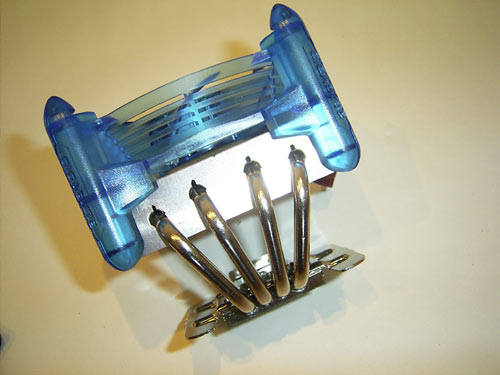 Right on the radiator, there is a 110 mm fan with a housing of blue plastic. On the frame, there are four blue LEDs which provide effective illumination while the cooler is running.  With the regulator, the user can adjust the fan's rotational speed within the range from 1700 to 3200 RPMs. At the same time, the noise level varies within 21 dBa to 45 dBa, with the air flow fluctuating within 36.2 CFM to 68.5 CFM.  The overall mass of the cooler is 430 g, which is relatively not much. The small weight of the cooler as well as its reliable fastening to the socket allow safely carrying the cooler around.  Take a close look at the base whose rear side is of quite intricate shape. That is made in order to provide a complete universality of the cooler. In particular, Gigabyte G-Power is compatible to all popular platforms: Socket478, Socket939, SocketA (Socket462), and SocketT (LGA775). To install the first three types of motherboards, various clips are used, and to fasten the cooler on a socket LGA775 motherboard a plastic fastening frame first has to be fitted (the design of the frame is completely similar to the frames used to install 3D Cooler series). Installation of the cooler on motherboards is not an issue at all. If the user is not experienced, the user guide comes in handy, which contains a great number of illustrations, with the text presented in nine languages. As regards the processing quality of the base, it is satisfactory: 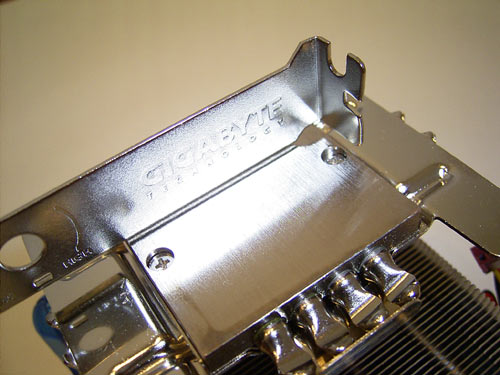 The cooler is equipped with a speed regulator unit, to which either a regulator into the 3" panel or a regulator on the bracket can be plugged in (the bracket is installed instead of one of the expansion cards). Of special mention is the very low noise level at the minimum speed. At this parameter, Gigabyte G-Power could be on par with Zalman produce. But if you put a hand to the radiator, you can feel quite an essential vibration, which points to the middling quality of the fan balancing (i.e. Gigabyte could have made the cooler much quieter). At the maximum RPMs, the cooler noise is quite tolerable, and at middle RPMs quite comfortable operation is possible. In conclusion, let me bring in a photo of the G-Power cooler installed on Gigabyte 8AENXP-D (i925XE) motherboard:  By the way, installation of the DPS module causes no issues: 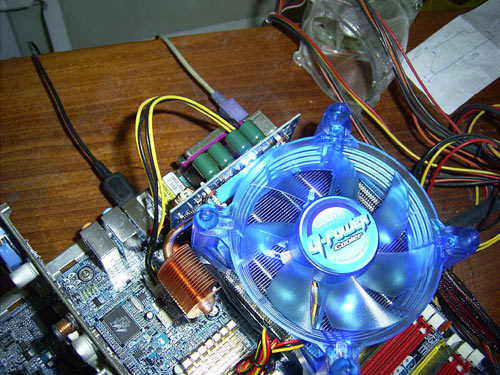 the new version of the module has special LEDs Pros:
Cons:
P.S. Along with traditional air-cooled devices, Gigabyte plans to release its own water-cooled system. It was first exposed at Cebit, and at the June's Computex a complete product was demonstrated. 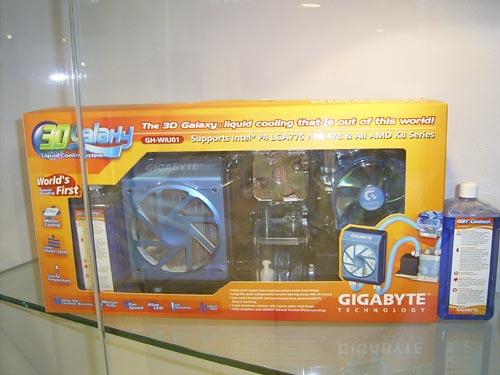 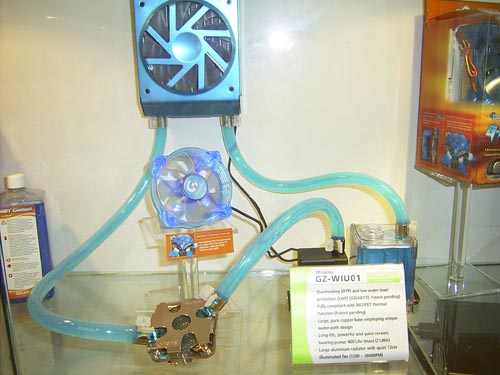 |
||||||||||||||
Management by AK Design VisualPharm.com |
|
|||





